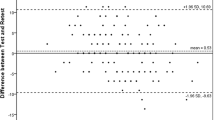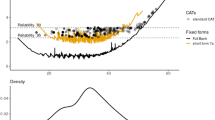Abstract
Purpose
The Hand10 is a self-administered questionnaire for upper extremity disorders. This questionnaire consists of 10 short, easy-to-understand questions and explanatory illustrations. In the shortening and validation process, the Hand10 demonstrated high acceptability and reliability among elderly individuals, with the advantage of being compact. We hypothesized that attached illustrations may contribute to the ability to maintain the psychometric properties of a questionnaire and raise acceptability for the elderly.
Methods
A series of 106 elderly patients with upper extremity disorders, whose symptoms had been stable, completed the Hand10, the Japanese Society for Surgery of the Hand Version of Disability of the Arm, Shoulder and Hand, and the Revised Hasegawa’s Dementia Scale. Participants were randomly allocated to receive either the illustrated Hand10 or the unillustrated Hand10. The potential advantages attributed to attached illustrations were investigated.
Results
No significant differences were found in baseline demographic data between subjects who received the illustrated and unillustrated questionnaires. The average percentage of items that the elderly patients left unanswered was 0.5 % for the illustrated Hand10 and 3.8 % for the unillustrated Hand10. Instrument test–retest reliability assessed with the intraclass correlation coefficient was 0.92 and 0.86, respectively.
Conclusion
The use of explanatory illustrations attached to the Hand10 contributed to raise acceptability for elderly patients and were suggested to improve the reproducibility.
Similar content being viewed by others
References
Carney, R., & Levin, J. (2002). Pictorial illustrations still improve students’ learning from text. Educational Psychology Review, 14(1), 5–26.
Houts, P. S., Doak, C. C., Doak, L. G., & Loscalzo, M. J. (2006). The role of pictures in improving health communication: A review of research on attention, comprehension, recall, and adherence. Patient Education and Counseling, 61(2), 173–190.
Holme, S. A., Man, I., Sharpe, J. L., Dykes, P. J., Lewis-Jones, M. S., & Finlay, A. Y. (2003). The children’s dermatology life quality index: Validation of the cartoon version. The British Journal of Dermatology, 148(2), 285–290.
Loo, W. J., Diba, V., Chawla, M., & Finlay, A. Y. (2003). Dermatology life quality index: Influence of an illustrated version. The British Journal of Dermatology, 148(2), 279–284.
Larson, C. O., Hays, R. D., & Nelson, E. C. (1992). Do the pictures influence scores on the Dartmouth COOP Charts? Quality of Life Research, 1(4), 247–249.
Kempen, G. I., van Sonderen, E., & Sanderman, R. (1997). Measuring health status with the Dartmouth COOP charts in low-functioning elderly. Do the illustrations affect the outcomes? Quality of Life Research, 6(4), 323–328.
Suzuki, M., Kurimoto, S., Shinohara, T., Tatebe, M., Imaeda, T., & Hirata, H. (2010). Development and validation of an illustrated questionnaire to evaluate disabilities of the upper limb. The Journal of Bone and Joint Surgery. British Volume, 92(7), 963–969.
Kurimoto, S., Suzuki, M., Yamamoto, M., Okui, N., Imaeda, T., & Hirata, H. (2011). Development and validation of a ten-item questionnaire with explanatory illustrations to assess upper extremity disorders: Favorable effect of illustrations in the item reduction process. Journal of Orthopaedic Science, 16(6), 737–744.
Beaton, D. E., Katz, J. N., Fossel, A. H., Wright, J. G., Tarasuk, V., & Bombardier, C. (2001). Measuring the whole or the parts? Validity, reliability, and responsiveness of the Disabilities of the Arm, Shoulder and Hand outcome measure in different regions of the upper extremity. Journal of Hand Therapy, 14(2), 128–146.
Imaeda, T., Toh, S., Nakao, Y., Nishida, J., Hirata, H., Ijichi, M., et al. (2005). Validation of the Japanese Society for surgery of the hand version of the disability of the arm, shoulder, and hand questionnaire. Journal of Orthopaedic Science, 10(4), 353–359.
Imai, Y., & Hasegawa, K. (1994). The Revised Hasegawa’s Dementia Scale (HDS-R)—evaluation of its usefulness as a screening test for dementia. Journal of the Hong Kong College of Psychiatrists, 4, 20–24.
McHorney, C. A., & Tarlov, A. R. (1995). Individual-patient monitoring in clinical practice: Are available health status surveys adequate? Quality of Life Research, 4(4), 293–307.
Fayers, P. M. (2000). Quality of life: Assessment, analysis and interpretation. Chichester: Wiley.
Davis, G. A., & Ball, H. E. (1989). Effects of age on comprehension of complex sentences in adulthood. Journal of Speech and Hearing Research, 32(1), 143–150.
Feier, C. D., & Gerstman, L. J. (1980). Sentence comprehension abilities throughout the adult life span. Journal of Gerontology, 35(5), 722–728.
Craik, F. I. M., & Trehub, S. (1982). Aging and cognitive processes (Advances in the study of communication and affect, Vol. 8). New York: Plenum Press.
Walmsley, S., Scott, K., & Lehrer, R. (1981). Effects of document simplification on the reading comprehension of the elderly. Journal of Reading Behavior, 13(3), 237–248.
Patel, V. L., Branch, T., & Arocha, J. F. (2002). Errors in interpreting quantities as procedures: The case of pharmaceutical labels. International Journal of Medical Informatics, 65(3), 193–211.
Park, D. C., & Schwarz, N. (1999). Cognitive aging : A primer. Philadelphia: Psychology Press.
Hadorn, D. C., Hays, R. D., Uebersax, J., & Hauber, T. (1992). Improving task comprehension in the measurement of health state preferences. A trial of informational cartoon figures and a paired-comparison task. Journal of Clinical Epidemiology, 45(3), 233–243.
Larkin, J. H., & Simon, H. A. (1987). Why a diagram is (sometimes) worth 10000 words. Cognitive Science, 11(1), 65–99.
Jadad, A. R., & Enkin, M. (2007). Randomized controlled trials : Questions, answers, and musings (2nd ed.). Malden, MA: Blackwell Publication.
Haywood, K. L., Garratt, A. M., & Fitzpatrick, R. (2005). Quality of life in older people: A structured review of generic self-assessed health instruments. Quality of Life Research, 14(7), 1651–1668.
Author information
Authors and Affiliations
Corresponding author
Rights and permissions
About this article
Cite this article
Kurimoto, S., Yamamoto, M., Shinohara, T. et al. Favorable effects of explanatory illustrations attached to a self-administered questionnaire for upper extremity disorders. Qual Life Res 22, 1145–1149 (2013). https://doi.org/10.1007/s11136-012-0233-4
Accepted:
Published:
Issue Date:
DOI: https://doi.org/10.1007/s11136-012-0233-4




